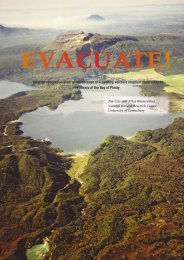Volcanoes - Ministry of Civil Defence and Emergency Management
Volcanoes - Ministry of Civil Defence and Emergency Management
Volcanoes - Ministry of Civil Defence and Emergency Management
Create successful ePaper yourself
Turn your PDF publications into a flip-book with our unique Google optimized e-Paper software.
experts <strong>and</strong> workshopped through the probabilities, we<br />
cannot get away from the fact that we do have a major<br />
problem in the hazard field with volcanoes.<br />
Now that the CDEM Act 2002 is a reality, we<br />
have formed our Bay <strong>of</strong> Plenty <strong>Civil</strong> <strong>Defence</strong> <strong>Emergency</strong><br />
<strong>Management</strong> (CDEM) Group. Along with the support <strong>of</strong><br />
the Coordinating Executive Group (CEG) our relevant<br />
working groups are going through a very robust process<br />
<strong>of</strong> deciding on the hazards affecting the Bay <strong>of</strong> Plenty<br />
Region, with volcanic eruption high on the list.<br />
RESEARCH INDICATORS<br />
Major earthquake <strong>and</strong> volcanic features <strong>of</strong> the Bay <strong>of</strong> Plenty<br />
occur. How prepared will the community be? How<br />
prepared will those vested with the responsibility <strong>of</strong> <strong>Civil</strong><br />
<strong>Defence</strong> <strong>Emergency</strong> <strong>Management</strong> be? The problem will<br />
not go away. The community must be resilient <strong>and</strong> accept<br />
that there are precautions <strong>and</strong> measures we all must take.<br />
The effects <strong>of</strong> a volcanic eruption <strong>and</strong> the effects<br />
<strong>of</strong> a distal eruption have been well researched over<br />
the past few years. Environment Bay <strong>of</strong> Plenty has<br />
commissioned a number <strong>of</strong> studies with the Institute <strong>of</strong><br />
Geological <strong>and</strong> Nuclear Sciences (GNS) <strong>and</strong> universities.<br />
These studies have proved to be invaluable in coming<br />
to grips with the magnitude <strong>of</strong> the problem. A number<br />
<strong>of</strong> graduates have prepared theses for Doctorates <strong>and</strong><br />
Masters Degrees on various aspects <strong>of</strong> the effects <strong>of</strong> the<br />
“Big One”. This big one being a volcano rather than our<br />
other major hazard <strong>of</strong> earthquakes. The fact that these<br />
people are interested in delving into the reasons why,<br />
<strong>and</strong> the possible effects <strong>of</strong> volcanic activity has certainly<br />
been a huge asset for those deciding on an emergency<br />
management approach. Having ploughed through the<br />
valuable data available <strong>and</strong> sought the advice <strong>of</strong> the<br />
The 1315AD eruption from Mt. Tarawera was<br />
the largest volcanic episode to have occurred in New<br />
Zeal<strong>and</strong> in the last 1000 years. Environment Bay <strong>of</strong><br />
Plenty held a “Kaharoa Eruption Hazards Workshop”<br />
in October 2000 where the event was studied <strong>and</strong><br />
implications drawn for a present day scenario. The<br />
results, as found by Russ Martin <strong>and</strong> Ian Nairn for<br />
“Volcanic Hazard Planning” in summary were:<br />
• The need to manage lengthy pre-eruption phases<br />
(1-10 years duration), with the likelihood <strong>of</strong> false<br />
alarms, conflicting scientific views on the likely<br />
outcome, sensational media treatment, public anxiety,<br />
<strong>and</strong> possibly severe adverse local economic effects.<br />
• The need to make detailed plans for an impending<br />
event <strong>of</strong> unknown start time, size, duration <strong>and</strong><br />
(wind-controlled) ashfall scenarios.<br />
• The need to manage a long-duration eruption with<br />
multiple large explosive events so that some areas<br />
receive repeated ashfalls over several months.<br />
• How to recognise (<strong>and</strong> guarantee) that the<br />
eruption has ended.<br />
• Assessment <strong>of</strong> the necessity <strong>and</strong> feasibility <strong>of</strong><br />
engineering intervention to reduce post-eruption<br />
flooding <strong>and</strong> sedimentation hazards.<br />
• The post-eruption impact on local government in the<br />
region <strong>and</strong> its functions.<br />
• When to start on clean-up operations, how to fund<br />
these, <strong>and</strong> how to select the priority areas.<br />
• How to manage the situation <strong>of</strong> accommodating <strong>and</strong><br />
rehabilitating perhaps up to 200,000 evacuees from<br />
the region?<br />
We can see from the above that the hazard<br />
implications are a grave cause for concern. For a<br />
Project Manager such as myself with the task <strong>of</strong> editing<br />
<strong>and</strong> putting together the Bay <strong>of</strong> Plenty <strong>Civil</strong> <strong>Defence</strong><br />
<strong>Emergency</strong> <strong>Management</strong> Group Plan, these studies are<br />
invaluable. Our Plan will go a long way to make the<br />
critical decision-making easier.<br />
As we read through the implications, the<br />
enormity <strong>of</strong> a volcanic eruption quickly becomes<br />
apparent. We are not talking about days, weeks or<br />
months but possibly years before anyone is allowed<br />
54<br />
TEPHRA<br />
June 2004

















